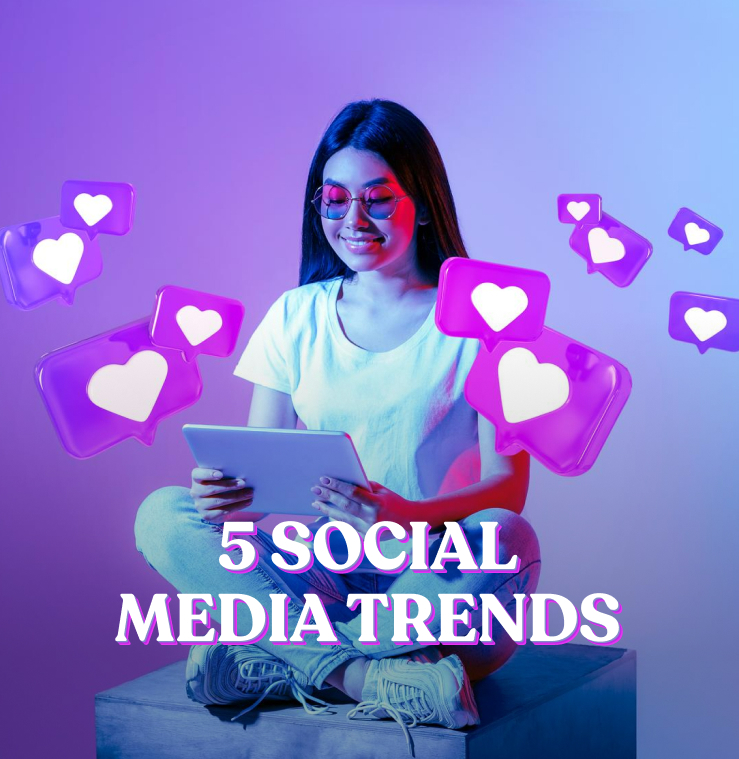In the ever-evolving world of social media, staying ahead of the curve is crucial. As we voyage into 2024, it’s time to explore what’s hot and what’s not in the social media landscape. From the rise of ephemeral content to the resurgence of old platforms, the trends are as diverse as they are exciting.
I’ve got my finger on the pulse, ready to guide you through the top 5 social media trends of 2024. Whether you’re a digital marketer, an influencer, or simply a social media enthusiast, this article will equip you with the insights you need to navigate the digital world. So, let’s dive in and discover the future of social media.
Overview of Social Media Trends in 2024
As we venture deeper into 2024, observing social media’s evolving landscape seems inevitable. Through this journey of comparison and contrast, I present both rising and declining trends.
Rising Trends to Watch
- Ephemeral Content: Ephemeral content, fleeting and tangible only for a short duration, stays the undisputed frontrunner. Instagram Stories, Snapchat clips, and TikTok videos exemplify this trend.
- Live Streaming: As authenticity gains currency, live streaming takes center stage. Instagram Live, for instance, provides a raw and unfiltered interface for real-time interactions.
- Social Commerce: Social commerce, shopping through social media platforms, continues to gain impetus. Instagram Shops, linking directly to business websites, epitomize this trend.
- Purpose-Led Campaigns: Highlighting brand ethos becomes increasingly popular as businesses align with progressive causes. Ben & Jerry’s social justice campaigns, for instance, resonate deeply with their consumer base.
- Voice and Visual Search: Advancements in AI lead to an increase in voice and visual search options. Google Assistant and Amazon’s Alexa with their hands-free capabilities contribute to this trend.
- Data Privacy Ignorance: With stricter data protection rules, inattention to data privacy loses ground. Companies incorporating clear privacy policies exemplify responsible conduct.
- Overuse of Hashtags: As engagement algorithms get sophisticated, overuse of hashtags is set aside for more organic engagement methods.
- Clickbait Content: Audiences demand credible content. As such, clickbait articles and misleading titles see a steep decline.
- Automated replies: Consumers crave personalized experiences, making automated replies less valued. A conversational approach, as seen in many customer service interactions, is preferred.
- Static, One-way Content: Interactive formats take precedence over one-way, static content. Use of polls, quizzes, and competitions on platforms like Instagram and Facebook sees a noticeable upsurge.

Trend 1: The Rise of AI-Driven Content
The trend of AI-driven content, a result of artificial intelligence advancements, holds a high position in the list of new-age social media trends. Its surge can’t be underestimated as it reshapes the approach of content creation and user engagement in the realm of social media.
Impact on Content Creation
AI shapes content creation by offering unique features. First, AI’s ability to analyze vast amounts of data facilitates predicting popular content trends. It helps platforms suggest content likely to resonate with their target audience. AI also personalizes content, tailoring it to suit individual preferences, lend credibility, and add a touch of personality that drives interaction and engagement. Finally, AI’s capacity to automate content creation—yes, the machines can create content!—frees human creators to channel their energy into higher-order tasks.
Let’s examine such instances. The New York Times, for example, uses Wordsmith, an AI developed by Automated Insights, to generate news stories from structured data. The Washington Post too employs a proprietary AI, Heliograf, which wrote 850 articles in its first year!
Implications for User Engagement
On the flip side, we’ve got some interesting implications of AI-driven content for user engagement. AI helps deliver highly personalized user experiences — an approach that’s completely reshaping user engagement strategies.
For instance, Netflix uses AI to provide personalized recommendations, enhancing user engagement by offering viewers more of what they’re interested in. Spotify utilizes AI too, observing user behavior to curate personalized playlists. These examples show that personalized content makes users feel valued and, consequently, more engaged.
That said, there’s an even more astounding feature that goes beyond personalized recommendations — AI-powered virtual assistants. Amazon’s Alexa and Apple’s Siri, among others, enable users to interact using voice commands, providing a wholly new, and interactive, user experience.
It’s clear that AI-driven content is much more than a fleeting trend. It’s an undeniable force, and its rise promises to continue shaping social media trends in 2024.
Trend 2: Enhanced Privacy and Security Features
Navigating the world of social media often means adapting to new trends, evolving user behavior, and constant shifts in policies. Among these, enhanced privacy and security features mark an important trend in 2024.
Shifts in Platform Policies
In response to the public’s concern for data privacy, significant changes occur in platform policies. Major platforms rollout changes in privacy policies and security measures, implementing tighter frameworks. Examples such as Facebook’s ‘Privacy Checkup’ and Instagram’s ‘Security Checkup’ provide insights into this shift. They aim to offer a more transparent approach towards data handling and user privacy. Accountability becomes a centerpiece in these policies, with violations resulting in severe penalties for platforms not honoring users’ privacy rights.
User Reaction and Adaptation
Users, in turn, become more vigilant and careful with their digital footprint. A rising trend sees individuals taking active steps in safeguarding their online persona. Increased usage of privacy tools becomes common in response to enhanced privacy measures introduced by platforms. Witness the rise of apps like ‘Signal’ and ‘Telegram,’ offering encrypted messaging services, as an example of users flocking towards more secure communication platforms. The adaptation to these security features reflects users’ reassessment of online safety practices and their shift towards a more privacy-conscious social media landscape in 2024.
Trend 3: Integration of Augmented Reality
Jumping into the third trend to witness in 2024, the integration of augmented reality (AR) stands as a prominent shift in social media trends, offering novelty and interactive capabilities.
AR in Advertising
I’ve observed a dynamic shift in advertising as marketers embrace AR to create immersive, interactive ads. Many brands, like IKEA and Lego, made use of AR to show customers how their products would look in real life. IKEA’s Place app, for instance, allows customers to visualize how furniture fits in their space. This trend provides marketers with a unique way of building deeper connections with consumers, and offering an experience rather than just a product, a trend I predict you’ll see more in 2024.
AR in User Interaction
But, AR doesn’t stop at advertising. User interaction also experiences an impactful change. Social platforms such as Snapchat have integrated AR to add another layer of entertainment to their platform. AR filters like face filters and World Lenses, transforming the back camera into a canvas for 3D interaction, are examples of AR applications. Instagram, not trailing behind, has made creating and sharing custom AR filters a breeze for users. As we forge ahead into 2024, I foresee more social media platforms harnessing AR capabilities, offering increasingly immersive and personalized experiences.
Trend 4: The Decline of Traditional Influencers
As we delve into the social media landscape in 2024, there’s a notable shift from traditional influencers with their massive followership, to a new breed of notable social media personas. This shift heartens marketers and brands as it harbors potential for more authentic connections with consumers.
Reasons Behind the Decline
Several factors have led to this decline. Firstly, audiences’ increasing scepticism has brought about concerns over authenticity. With high numbers of followers, they are doubting whether influencer advice is genuine or driven by sponsorships. Cases like the Fyre Festival, where influencers promoted a fraudulent event, add to this trend.
Secondly, the surge in ‘bot’ followers or bought followers dents credibility. The infamous case of Caroline Calloway, who had a bona fide following but struggled to deliver on a paid partnership, underscores this point.
Lastly, shifts in algorithm favoring engaging content over mass followership also play a role in the decline. This trend became apparent in Instagram’s move to hide likes, shifting emphasis to crafting engaging content.
Emerging Types of Influencers
On the flip side, I observe the rise in emerging types of influencers that are rapidly gaining traction among marketers. The prevalent categories include:
-Micro and nano influencers: These influencers may have less than 10,000 followers, yet their engagement rates often trump those of mega influencers. Examples incorporate fashion blogger Sophie Suchan, with approximately 9,000 followers, and mom-blogger Amanda Muse with roughly 40,000 followers.
-Subject-matter experts: Whether it’s fitness, veganism, or digital marketing, these influencers are esteemed for their expertise in a specific field. Case in point is Joe Wicks, a popular fitness expert with millions of followers.
-Employee influencers: An innovative trend is for companies to leverage their employees to act as influencers. They are seen as trusted voices, reinforcing the brand’s credibility and authenticity. Adobe is an outstanding example, as it has a robust employee advocacy program.
As defining the moment in 2024, this shift from traditional influencers towards more authentic ambassadors and advocates signals a need for a new influencer strategy for brands and marketers alike. Continuing this journey, let’s now proceed to our final trend, a captivating fusion of technology and creativity.
Trend 5: Growth of Niche Social Platforms
As we traverse deeper into 2024’s social media landscape, it’s become evident that the spotlight is shifting towards niche social platforms. These are curated online spaces that cater specifically to targeted audiences, enabling a more personalized and focused social media experience. Contrary to major platforms that aim to appeal to diverse masses, these niche networks zero in on specific interests, professions, hobbies, or demographics, making them a significant trend to watch this year.
Examples of Niche Platforms
In this vast digital arena, certain niche platforms come to light with their unique offerings. Networks such as Goodreads, a book-lovers’ haven, and Houzz, an interior design enthusiast’s playground, are prime examples.
Additionally, platforms like Fishbrain, dedicated to the angling community, and Strava, built specifically for athletes, highlight the varied scope of these niche networks. In the professional field, networks like ResearchGate and Academia.edu offer scholarly interaction, while creative spaces like Behance and Dribble cater to designers and artists respectively.
Benefits to Targeted Audiences
Targeted audiences stand to gain significantly from these specialized networks. With a focused platform, individuals can discover, share, and engage around their specific interests or professions. It facilitates meaningful interactions amongst users, fostering tighter-knit communities bound by a shared passion or pursuit.
In addition, businesses operating within these niches find value in directly reaching a dedicated and engaged audience, thus increasing the effectiveness of their branding and marketing efforts. In the light of these advantages, the growth of niche social platforms in 2024 remains a trend worth noting.
Conclusion
So there you have it. We’ve navigated the choppy waters of 2024’s social media scene together. From the rise of ephemeral content and live streaming to the growth of social commerce and purpose-led campaigns, it’s clear that this year is all about dynamic, interactive, and meaningful engagement.
We’ve also seen how AI and AR are transforming the way we interact online, while new influencer categories and niche platforms are redefining our understanding of social media influence and community. Remember, it’s not just about keeping up with the trends. It’s about understanding how these shifts can benefit your brand and your audience. So don’t be afraid to dive in, experiment, and find what works best for you. After all, in the fast-paced world of social media, staying still is not an option.
 Boosting Engagement with Clickable Videos: Your Secret Weapon for Content Success
Boosting Engagement with Clickable Videos: Your Secret Weapon for Content Success  Shoppable Videos: 7 Interesting tips to Make the Most Out of This Trend?
Shoppable Videos: 7 Interesting tips to Make the Most Out of This Trend?  How Content Marketing Boosts Sales
How Content Marketing Boosts Sales  8 Good Interactive Instagram Story Ideas for Business
8 Good Interactive Instagram Story Ideas for Business  Maximizing ROI: Are Short-Form Videos the Future of Content Marketing?
Maximizing ROI: Are Short-Form Videos the Future of Content Marketing?